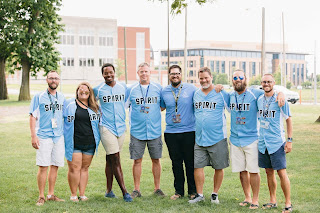As the light touches the horizon by Andrew F. Poor
Composed for the students of South Forsyth Middle School in Cumming, Georgia. This work for young bands was composed as a lyrical showcase for the composer’s students and is composed in a binary form—AABA. The primary theme is first presented as a plaintive clarinet solo/optional trumpet (measure 2) and has some folk-like qualities performed over a pedal-point. The second presentation of the A theme (measure 19) is presented by the trumpets and enhanced harmonic vocabulary. The B theme (measure 35) moves to the relative minor (C minor), represents the clouds
briefly covering our horizon, and the melody is passed through various woodwind instruments. A cadential extension leads us to a full tutti statement of the A theme (measure 53), which is followed by a brief concluding section at measure 67. The Coda to the piece features a fragmenting and augmenting of the main melody, which is shared through various instruments and leads us to a final cadence.
As the title suggests, the piece should begin with a gentle and distant feel to the music. Performers should strive to maintain excellent balance of the accompaniment parts to the melody at all times. Conductors are encouraged to take liberties with the tempos, especially at phrase endings, so the music has a greater sense of freedom and flow. Performers should be reminded to perform longer phrases and avoid common misplaced breaths at bar lines and following most longer valued notes. Be sure to play all sustained tones into rests and all articulations should be performed in a tenuto/sustained style. Soloists are encouraged to perform in a cantabile style to reinforce the song-like character of the melody. The final note of the piece is truly a metered
fermata and should be performed with that approach.
briefly covering our horizon, and the melody is passed through various woodwind instruments. A cadential extension leads us to a full tutti statement of the A theme (measure 53), which is followed by a brief concluding section at measure 67. The Coda to the piece features a fragmenting and augmenting of the main melody, which is shared through various instruments and leads us to a final cadence.
As the title suggests, the piece should begin with a gentle and distant feel to the music. Performers should strive to maintain excellent balance of the accompaniment parts to the melody at all times. Conductors are encouraged to take liberties with the tempos, especially at phrase endings, so the music has a greater sense of freedom and flow. Performers should be reminded to perform longer phrases and avoid common misplaced breaths at bar lines and following most longer valued notes. Be sure to play all sustained tones into rests and all articulations should be performed in a tenuto/sustained style. Soloists are encouraged to perform in a cantabile style to reinforce the song-like character of the melody. The final note of the piece is truly a metered
fermata and should be performed with that approach.



Comments
Post a Comment